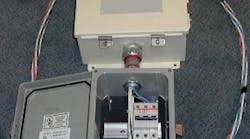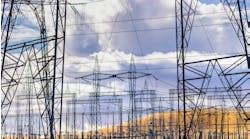The Basics of Using Circuit Breakers with Surge Protectors
In the electrical profession, questions still arise about what type of circuit breaker to use with surge protectors. Don't make this task more difficult than it has to be. Choosing the right device is straightforward, as long as you follow some basic steps and have a fundamental understanding of surge protectors.
Application
Essentially, the circuit breaker must be sized to the protector's wire size and the electrical panel's ratings. For example, a surge protector with 10 AWG wires should be used with a breaker rated at 30A. The circuit breaker's ratings (interrupt rating, voltage rating) must also be suitable for the panel. Of course, to be 100% sure, follow the surge protection manufacturer's installation instructions. The Figure (click here to see Figure) shows a typical installation of a 120/240VAC-rated surge protector connected to a panel.
Benefits
In addition to safety, the surge protector's dedicated breaker performs the following functions:
- Allows power to the protector to be removed without interrupting power to other loads.
- Should a component fail inside the protector, only the protector's breaker will trip, and power to other loads is not disturbed.
Performance
Most manufacturers do not test circuit breakers to determine performance when subject to industry standard surge current waveforms. These waveforms are extremely fast (microseconds in duration).
Standard UL489-listed, Heating Air Conditioning and Refrigeration (HACR)-rated, thermal-magnetic breakers perform well when used with surge protectors. This means passing high amplitude surge current without tripping. After all, you don't want your breaker tripping during a surge and disconnecting your protector. Keep in mind the following different definitions of the term “surge current”:
- Surge current — the current formed as a result of an abnormal overvoltage (i.e., lightning, utility switching).
- Surge current or iinrush current — the maximum, instantaneous input current drawn by an electrical device when first turned on.
“High inrush”-rated breakers (applications include motors and HID lighting, etc.) offer even better performance than standard load center-type breakers. However, these breakers are about five times more expensive than standard plug-in-type load center breakers. DIN-rail mount-style breakers with cage clamp screw terminals for the line and load connections may require a separate enclosure be used to house the circuit breaker.
Ground fault circuit interrupter (GFCI), arc fault circuit interrupter (AFCI), and combination arc fault circuit interrupter (CAFCI) breakers are not recommended for use with surge protectors; however, they may coexist with standard thermal-magnetic breakers in the same panel.
GFCI breakers, which sense for ground faults, can trip when a protector diverts current to ground. AFCI breakers, which sense for line-to-neutral (L-N) and line-to-ground (L-G) arcs, may also nuisance trip during a surge event. The same nuisance tripping may occur with CAFCI breakers, which sense for L-N, L-G, and series arcs. All of these “smart” circuit breakers are equipped with electronics, which makes them more prone to surge damage. Therefore, surge protection is a good idea on panels with these types of breakers employed.
To recap, circuit breakers with a Type D time-current curve outperform standard load center circuit breakers with the same ratings (e.g., AIC, rated current, voltage). Although higher in price than their proliferated load center counterparts, their higher surge current capacity provides the necessary performance needed in critical applications. GFCI, AFCI, and CAFCI circuit breakers are not recommended to be used to wire surge protectors due to their tendency to trip when a surge protector diverts current during a surge event.
Rated current
Given a certain series of thermal-magnetic circuit breakers, the breaker with the higher-rated current figure will outperform the same style of breaker with a lower-rated current when speaking of passing transient (surge) currents. For example, a 30A breaker will have better surge performance than a 20A breaker of the same type. This may make you ask, “Why don't I use a 100A-rated current breaker and really benefit from it?” Although using a 100A breaker appears to be a good way to go, in most cases, it will result in the following:
- Circuit breaker cost increases.
- Wire cost increases as a larger wire size rated for the larger breaker must be used.
- Installation time increases as the installer must now work with cumbersome larger gauge wire, larger conduits, and fittings.
- The larger cross-sectional area of the larger wire offers little to no benefit, because 10AWG wire can pass 150,000A (8×20 microseconds) of surge current. However, industry standards show that 10,000A (8×20 microseconds) is the highest energy waveform you can be exposed to in a typical residential/commercial service entrance location.
- The larger breaker may not be properly coordinated with the panel's main breaker or main lug only (MLO) panel's upstream breaker. A fault in the protector has a very good chance of also tripping the panel's main breaker or MLO panel's upstream breaker due to the 100A breaker dedicated to the protector.
Stand-alone disconnect switches and surge protectors
In certain surge protector applications, a stand-alone circuit breaker is needed to ensure a safe and reliable system. A stand-alone breaker is one that is not part of the load center (service panel) or the protector. Such a setup is also used with large switchgear, where typically no small branch breakers exist — only large breakers servicing large loads or parts of a facility. Keep in mind that the fault current rating of the protector's breaker must be sized properly for the application.
This approach is sometimes implemented using a separate fused disconnect switch in series with the protector. The Photo (left) shows a setup whereby a 3-pole breaker is used to service the surge protector, which is equipped with a low-impedance 10AWG cable. This type of installation affords the convenience and most of the safety aspects as a load center's breaker. It's also a good way to employ the specialty, high-performance circuit breakers mentioned earlier.
The above approach will protect the connection wires from overheating during a fault within the protector or between the protector and the breaker's output side. It also allows easy power removal of protector for servicing or replacement. If you are using this type of installation, maintain short lead lengths as parallel-connected surge protectors require short lead lengths to be effective. With standard wiring, typically no more than 36-in. cable length should be used between the protector and the power source — this includes the length of the separate disconnect switch's enclosure. Longer lead lengths are possible with a low-impedance connection cable offered by some manufacturers.
Using a dedicated circuit breaker with surge protection can improve overall system reliability. In most surge protector applications, using anything more than a 30A breaker is excessive and can actually decrease system reliability, if breaker coordination is not observed. Although there are differences in the surge current capacity of breakers, even the most common and lowest-priced UL489-listed breakers work well with surge protectors and provide an extra measure of safety and convenience.
Dion Neri is an engineering manager with MCG Surge Protection, Deer Park, N.Y. He can be reached at [email protected].
Sidebar: Using Fuses with Surge Protectors
Fuses, like circuit breakers, are also considered overcurrent devices. In certain cases, fuses (i.e., a fused disconnect switch or a fuse block) may be used in series with a surge protector. Time-delay (and SLO-BLO) fuse types have good surge current capability. But unlike a circuit breaker (with common trip), fuses are not ganged. So if there is a problem with one phase of a protector and that fuse operates, the other two phases of the protector still have power to them. On one hand, this outcome may be desirable as the protection circuits on those two phases are still online and protecting. From a safety consideration, this may not be advantageous as power is present inside of an already damaged piece of equipment. A circuit breaker or a fused disconnect can easily be turned off to remove power to the protector. However, if a fuse block is used, all of the fuses must be carefully extracted before power is completely removed from the protector.
Keep in mind, if a surge protector has been tested at Underwriters Laboratories (UL) using a circuit breaker, substituting a fuse may void the UL listing and also may result in an unsafe installation, and vice versa.



